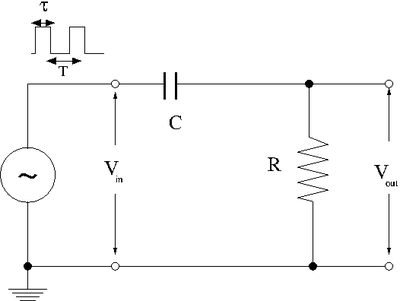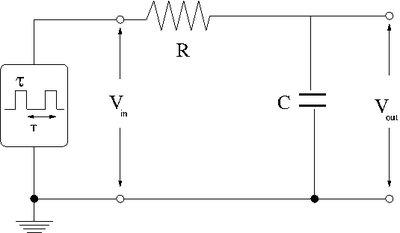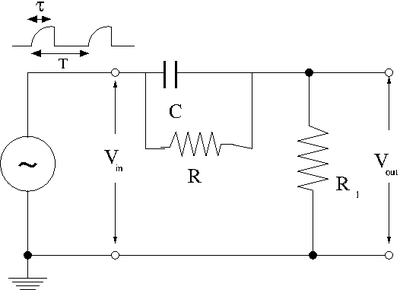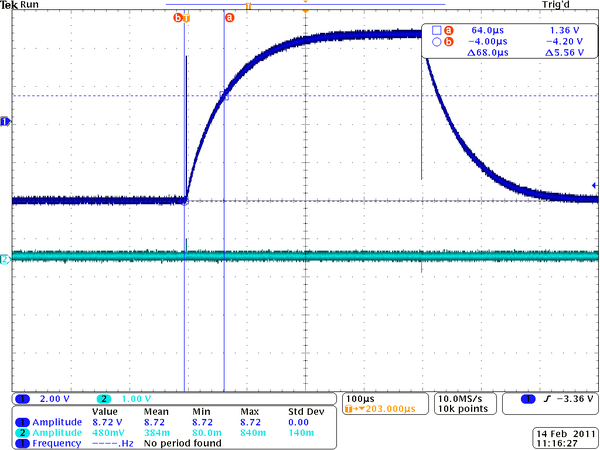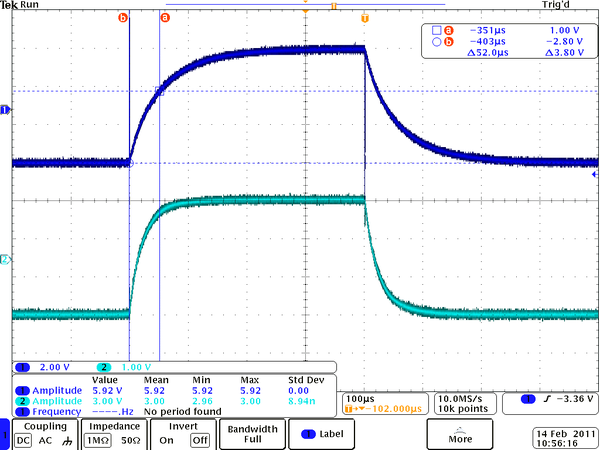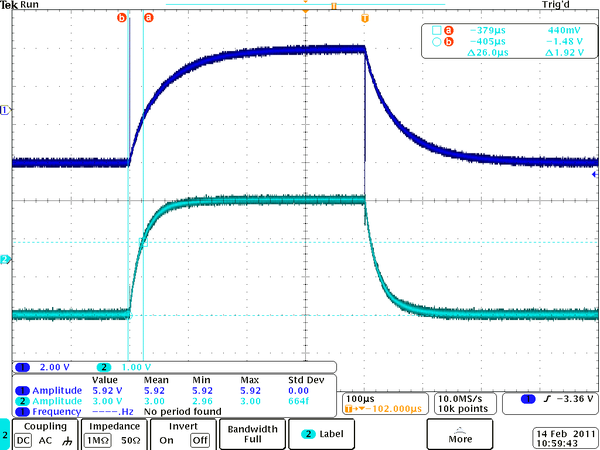Difference between revisions of "Lab 6 RS"
| (98 intermediate revisions by the same user not shown) | |||
| Line 13: | Line 13: | ||
| − | + | Taking <math>R = 989\ \Omega</math> and <math>C_{out} = 1.255\ \mu F\ \Rightarrow \tau = RC = 1.24\ ms</math> | |
==Adjust the pulse generator to output square pulses which at <math>\tau \approx</math> RC/10, RC and 10 RC== | ==Adjust the pulse generator to output square pulses which at <math>\tau \approx</math> RC/10, RC and 10 RC== | ||
| − | 1) <math>\tau \approx \frac{ | + | 1) <math>\tau \approx \frac{1.24\ ms}{10} \approx 0.124\ ms </math> |
| − | 2) <math>\tau \approx | + | 2) <math>\tau \approx 1.24\ ms </math> |
| − | 3) <math>\tau \approx 10 \cdot | + | 3) <math>\tau \approx 10 \cdot 12.4\ ms \approx 124\ ms </math> |
==Measure<math> V_{in}</math> and <math>V_{out}</math>. Sketch a picture comparing<math> V_{out}</math> and <math>V_{in}</math>. ( 3*5 = 15 pnts.)== | ==Measure<math> V_{in}</math> and <math>V_{out}</math>. Sketch a picture comparing<math> V_{out}</math> and <math>V_{in}</math>. ( 3*5 = 15 pnts.)== | ||
| Line 27: | Line 27: | ||
{| border="1" cellspacing="0" style="text-align: center" | {| border="1" cellspacing="0" style="text-align: center" | ||
| − | |+ '''Table1. Differentiator circuit for different pulse width''' | + | |+ '''Table1. Differentiator circuit for different pulse width''' |
|- | |- | ||
| − | ! scope="col" width="50" height="60" | <math>\tau \approx 0. | + | ! scope="col" width="50" height="60" | <math>\tau \approx 0.124\ ms </math> |
| − | ! scope="col" width="50" | <math>\tau \approx | + | ! scope="col" width="50" | <math>\tau \approx 1.24\ ms </math> |
| − | ! scope="col" width="50" | <math>\tau \approx | + | ! scope="col" width="50" | <math>\tau \approx 12.4\ ms </math> |
|- | |- | ||
| − | | [[File: | + | | [[File:Tek00017.png | 350 px]] || [[File:Tek00018.png | 350 px]] || [[File:Tek00019.png | 350 px]] |
|} | |} | ||
| − | From the plots above: | + | From the plots above (at point a): |
| − | <math>\tau = 0. | + | <math>\tau = 0.124\ ms \rightarrow V_1 = 8.0\ V,\ V_2 = 8.0\ V</math> |
| − | <math>\tau = | + | <math>\tau = 1.24\ ms \rightarrow V_1 = 8.0\ V,\ V_2 = 8.0\ V</math> |
| − | <math>\tau = | + | <math>\tau = 12.4\ ms \rightarrow V_1 = 8.0\ V,\ V_2 = 8.0\ V</math> |
| − | == | + | ==Questions== |
| − | + | ===What happens if the amplitude of <math>V_{in}</math> is doubled.( 5 pnts.)=== | |
| − | + | The amplitude of <math>V_{out}</math> is doubled as well. | |
| − | + | ===What happens if R is doubled and C is halved?( 5 pnts.)=== | |
| + | The times constant <math>\tau_{RC} =(R/2)(2C) = RC</math> becomes unchangeable so nothing is really happened | ||
| − | + | =Integrator= | |
| − | + | Now repeat the above experiment with the resistor and capacitor swapped to form the low pass circuit below. | |
| − | |||
| − | + | [[File:TF_EIM_PulsedRCLowpass.png | 400 px]] | |
| − | :<math>\tau \approx | + | {| border="1" cellspacing="0" style="text-align: center" |
| + | |+ '''Table1. Integrating circuit for different pulse width''' | ||
| + | |- | ||
| + | ! scope="col" width="50" height="60" | <math>\tau \approx 0.124\ ms </math> | ||
| + | ! scope="col" width="50" | <math>\tau \approx 1.24\ ms </math> | ||
| + | ! scope="col" width="50" | <math>\tau \approx 12.4\ ms </math> | ||
| + | |- | ||
| + | | [[File:Tek00020.png | 350 px]] || [[File:Tek00021.png | 350 px]] || [[File:Tek00022.png | 350 px]] | ||
| + | |} | ||
| − | |||
| − | |||
| + | From the plots above (at point b): | ||
| − | + | <math>\tau = 0.124\ ms \rightarrow V_1 = 8.0\ V,\ V_2 = 0.4\ V</math> | |
| − | + | <math>\tau = 1.24\ ms \rightarrow V_1 = 8.0\ V,\ V_2 = 4.4\ V</math> | |
| − | + | <math>\tau = 12.4\ ms \rightarrow V_1 = 8.0\ V,\ V_2 = 8.8\ V</math> | |
| − | |||
==Questions== | ==Questions== | ||
===What happens if the amplitude of <math>V_{in}</math> is doubled.( 5 pnts.)=== | ===What happens if the amplitude of <math>V_{in}</math> is doubled.( 5 pnts.)=== | ||
| + | |||
| + | The amplitude of <math>V_{out}</math> is doubled as well. | ||
===What happens if R is doubled and C is halved?( 5 pnts.)=== | ===What happens if R is doubled and C is halved?( 5 pnts.)=== | ||
| − | The times constant <math>\tau_{RC} = | + | The times constant <math>\tau_{RC} = (R/2)(2C) = RC</math> becomes unchangeable so nothing is really happened |
| + | |||
| + | =Pulse Sharpener= | ||
| + | |||
| + | The goal of this section is to demonstrate how well the circuit below can sharpen an input pulse | ||
| + | |||
| + | [[File:TF_EIM_Lab6a.png| 400 px]] | ||
| + | |||
| + | 1.) The first step is to create an input pulse which is rounded, similar to the output of the integrator circuit when RC = 10 <math>\tau</math>. You can do this using a capacitor shorted across the output of the pulse generator. This will essential be coupled to the input impedance of the pulse generator and form a low pass circuit. | ||
| + | |||
| + | As a result the input voltage is given as | ||
| + | |||
| + | :<math>V_{in} = V_0 \left ( 1 - e^{-t/\tau}\right )</math> | ||
| + | |||
| + | where | ||
| + | |||
| + | : <math>\tau=R_{out} C_{out}</math> | ||
| + | :<math>R_{out}</math> = impedance of the function generator at output which produces V_{in} | ||
| + | : <math>C_{out}</math> = capacitor shorting the function generator output to ground (not shown in the above picture) | ||
| − | |||
| − | + | Taking <math>C_{out} = 1.235 \mu F</math> and by measurement of rising time <math>\tau = RC = 68.0\ us</math> I was able to estimate the input impedance of oscillator plus cable equal to <math>55\ \Omega</math>. This measurements was done by taking oscillator input and plus capacitor shorted acros the output without any aditional circut. | |
| − | |||
| − | + | [[File:Tek00028.png | 600 px]] | |
| − | |||
| − | |||
| − | + | 2.) The output should be given by | |
| + | :<math>V_{out} = V_0^{\prime} \left ( 1 - e^{-t/\tau^{\prime}}\right )</math> | ||
| − | + | where | |
| − | + | :<math>\tau^{\prime} =\left ( \frac{R_1 R}{R_1+ R}\right )C_1</math> | |
| − | |||
| − | |||
| − | |||
| − | == | + | ==Make measurements of the rise time <math>\tau</math> and <math>\tau^{\prime}</math>. The rise time is defined as the time it take the pulse to go from 10% of its max value to 90% of its max value.( 5 pnts.)== |
| − | + | ==='''Rise time <math>\tau</math> measurements '''=== | |
| + | [[File:Tek00026.png | 600 px]] | ||
| − | |||
| − | + | :Input voltage is given by <math>V_{in} = V_0 \left ( 1 - e^{-t/\tau}\right ),\ V_0 = 6\ V</math> | |
| − | |||
| − | == | + | :At time <math>t = 0 \rightarrow V_{in} = 0</math> |
| + | :At time <math>t = \tau \rightarrow V_{in} = 6 \left ( 1 - e^{-1}\right ) = 3.79\ V</math> | ||
| − | + | To define the rise time I have used different definition. It is time when <math>t = \tau</math> under the exponent function so the exponent becomes <math>e^{-1}</math> | |
| − | + | From the plot above my measurement of rise time is: | |
| − | + | <math>\tau = (52 \pm 0.2)\ us</math> | |
| + | ==='''Rise time <math>\tau^{\prime}</math> measurements '''=== | ||
| − | + | [[File:Tek00027.png | 600 px]] | |
| − | |||
| − | |||
| − | == | + | :Output voltage is given by <math>V_{out} = V_0^{\prime} \left ( 1 - e^{-t/\tau^{\prime}}\right ),\ V_0^{\prime} = 3.04\ V</math> |
| − | + | :At time <math>t = 0 \rightarrow V_0^{\prime} = 0</math> | |
| + | :At time <math>t = \tau^{\prime} \rightarrow V_0^{\prime} = 3.04 \left ( 1 - e^{-1}\right ) = 1.92\ V</math> | ||
| − | + | To define the rise time I have used different definition. It is time when <math>t = \tau</math> under the exponent function so the exponent becomes <math>e^{-1}</math> | |
| − | + | From the plot above my measurement of rise time is: | |
| + | <math>\tau^{\prime} = (26.0 \pm 2.0)\ us</math> | ||
| − | = | + | ==Compare the measurement of <math>\tau^{\prime}</math> to what you expected based on your measured values of <math>C_1</math>, <math>R_1</math> and <math>R</math>.( 15 pnts.)== |
| − | + | '''Expected value: ''' | |
| − | + | Taking | |
| + | :<math>R = (49.8 \pm 0.1)\ \Omega ,</math> <math>R_1 = (51.1\ \pm 0.1)\ \Omega</math> and <math>C_1 = (1.225\ \pm 0.05)\ \mu F</math> | ||
| − | + | I was able to estimate the expected value of rising time is equal to | |
| + | :<math> \tau^{\prime} = \left ( \frac{R_1 R}{R_1+ R}\right )C_1 = (30.9\ \pm 0.13)\ us</math> | ||
| − | + | '''Measured value:''' | |
| − | :<math> | + | Our measured value of rising time is equal to |
| + | :<math>\tau^{\prime} = (26.0 \pm 2.0)\ us</math> | ||
| − | |||
| − | |||
| − | |||
| − | |||
| − | + | As we can see from results above my measured and expected value different one from each other more then absolute values of error interval. The reason can be in derivation of expected value of <math> \tau^{\prime} = \left ( \frac{R_1 R}{R_1+ R}\right )C_1</math>. This result is the solution of inhomogeneous differential equation: | |
| − | + | <math>\frac{dV_{out}}{dt} + \frac{(R+R_1)}{CRR_1} V_{out} = V_0 \left ( \frac{1}{\tau_{in}} - \frac{1}{CR}\right )e^{-t/\tau_{in}} + \frac{V_0}{CR} </math> | |
| − | |||
| − | + | And in order to this result be true the <math>\tau_{in}</math> should be equal to <math>R\ C</math>. Then the term <math>\left ( \frac{1}{\tau_{in}} - \frac{1}{CR}\right )</math> in equation above will be zero and the solution becomes <math>V_{out} = \frac{R_1}{R+R_1}V_0 (1- e^{-t/\tau_{out}})</math> | |
| + | where <math>\tau_{out} = C \frac{RR_1}{R+R_1} </math> that gives us the result above about rising time of output voltage. | ||
| − | |||
| − | + | In real situation the term <math>\left ( \frac{1}{\tau_{in}} - \frac{1}{CR}\right )</math> is not equal to zero and we can not really use the formula <math> \tau^{\prime} = \left ( \frac{R_1 R}{R_1+ R}\right )C_1</math>. That can be seen from my measurements of rising time of input pulse for two cases: 1) with capacitor shorted the oscillator but without any additional circuit in output <math>\tau = 68\ us</math> and 2) with real circuit <math>\tau = 52.0\ us</math>. In this case the theoretical values of expected error is difficult to handle. We need somehow to solve this equation exactly that could be done numerically or we need somehow to estimate the error of not including this term in equation. | |
==Questions== | ==Questions== | ||
1.) Qualitatify, why is <math>\tau^{\prime} < \tau</math>?( 10 pnts.) | 1.) Qualitatify, why is <math>\tau^{\prime} < \tau</math>?( 10 pnts.) | ||
| + | |||
| + | :<math>\tau_{out} = C \frac{R R_1}{R+R_1} =\frac{R_1}{R+R_1} \tau_{in} < \tau_{in} </math> so <math>\tau_{out}</math> is always less than <math>\tau_{in}</math>. | ||
| + | |||
| + | Qualitatively we can think about circuit above as differentiator. Because of taking derivative of input shape, output voltage shape becomes more sharpened. It is explain why the rising time of output voltage becomes less than input one. | ||
2.) How is <math>V_{out}</math> worse than <math>V_{in}</math>( 10 pnts.) | 2.) How is <math>V_{out}</math> worse than <math>V_{in}</math>( 10 pnts.) | ||
| + | |||
| + | <math>V_{out} = \frac{R_1}{R+R_1}V_0 (1- e^{-t/\tau_{out}})</math> | ||
| + | |||
| + | So the output voltage is always less then input one by the factor <math>\frac{R_1}{R+R_1}</math> | ||
Latest revision as of 17:07, 24 February 2011
Lab 6 Pulses and RC Filters
Differentiator
Construct the circuit below selecting an RC combination such that RC s
Taking and
Adjust the pulse generator to output square pulses which at RC/10, RC and 10 RC
1) 2) 3)
Measure and . Sketch a picture comparing and . ( 3*5 = 15 pnts.)
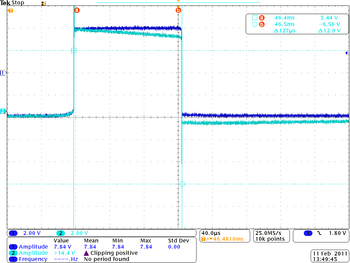 |
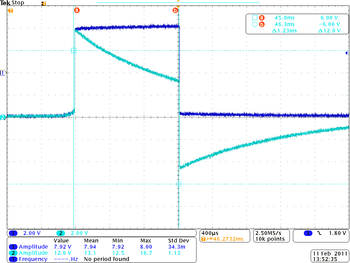 |
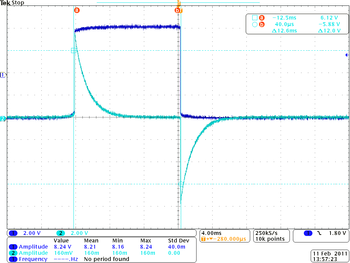
|
From the plots above (at point a):
Questions
What happens if the amplitude of is doubled.( 5 pnts.)
The amplitude of is doubled as well.
What happens if R is doubled and C is halved?( 5 pnts.)
The times constant becomes unchangeable so nothing is really happened
Integrator
Now repeat the above experiment with the resistor and capacitor swapped to form the low pass circuit below.
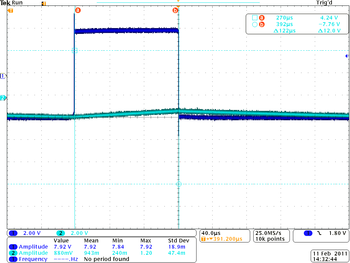 |
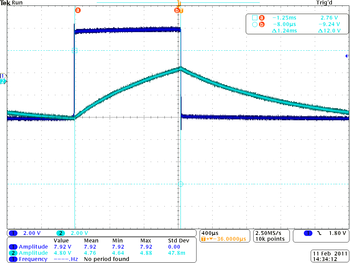 |
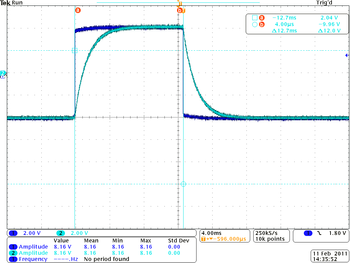
|
From the plots above (at point b):
Questions
What happens if the amplitude of is doubled.( 5 pnts.)
The amplitude of is doubled as well.
What happens if R is doubled and C is halved?( 5 pnts.)
The times constant becomes unchangeable so nothing is really happened
Pulse Sharpener
The goal of this section is to demonstrate how well the circuit below can sharpen an input pulse
1.) The first step is to create an input pulse which is rounded, similar to the output of the integrator circuit when RC = 10 . You can do this using a capacitor shorted across the output of the pulse generator. This will essential be coupled to the input impedance of the pulse generator and form a low pass circuit.
As a result the input voltage is given as
where
- = impedance of the function generator at output which produces V_{in}
- = capacitor shorting the function generator output to ground (not shown in the above picture)
Taking and by measurement of rising time I was able to estimate the input impedance of oscillator plus cable equal to . This measurements was done by taking oscillator input and plus capacitor shorted acros the output without any aditional circut.
2.) The output should be given by
where
Make measurements of the rise time and . The rise time is defined as the time it take the pulse to go from 10% of its max value to 90% of its max value.( 5 pnts.)
Rise time measurements
- Input voltage is given by
- At time
- At time
To define the rise time I have used different definition. It is time when under the exponent function so the exponent becomes
From the plot above my measurement of rise time is:
Rise time measurements
- Output voltage is given by
- At time
- At time
To define the rise time I have used different definition. It is time when under the exponent function so the exponent becomes
From the plot above my measurement of rise time is:
Compare the measurement of to what you expected based on your measured values of , and .( 15 pnts.)
Expected value:
Taking
- and
I was able to estimate the expected value of rising time is equal to
Measured value:
Our measured value of rising time is equal to
As we can see from results above my measured and expected value different one from each other more then absolute values of error interval. The reason can be in derivation of expected value of . This result is the solution of inhomogeneous differential equation:
And in order to this result be true the should be equal to . Then the term in equation above will be zero and the solution becomes
where that gives us the result above about rising time of output voltage.
In real situation the term is not equal to zero and we can not really use the formula . That can be seen from my measurements of rising time of input pulse for two cases: 1) with capacitor shorted the oscillator but without any additional circuit in output and 2) with real circuit . In this case the theoretical values of expected error is difficult to handle. We need somehow to solve this equation exactly that could be done numerically or we need somehow to estimate the error of not including this term in equation.
Questions
1.) Qualitatify, why is ?( 10 pnts.)
- so is always less than .
Qualitatively we can think about circuit above as differentiator. Because of taking derivative of input shape, output voltage shape becomes more sharpened. It is explain why the rising time of output voltage becomes less than input one.
2.) How is worse than ( 10 pnts.)
So the output voltage is always less then input one by the factor
